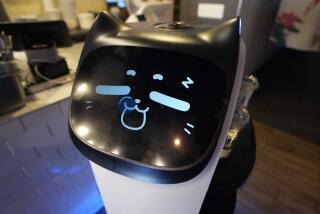Leaving Mundane Cleaning to Automatons
- Share via
RICHMOND, Va. — Dottie takes the elevator to her cleaning job, turns on her vacuum and spends the next five hours sucking up dirt from office corridors. And she doesn’t earn a penny.
That’s because Dottie is a robot.
Buck Ward, who helped create Dottie, toyed with the idea of a robot cleaner for more than a decade. He’s one of the owners of Cyberclean Systems, a Richmond office-cleaning company.
“In 1983, we had a contract to clean a Sears store in Richmond,” he said. “I found myself in that store one morning at 5 a.m. with none of the 10 people who were supposed to be there. After shouting and yelling, I took a dust mop and started going down the aisles.
“I told myself there should be a way to create a robot to do this,” he said. “It’s monotonous, repetitive and mundane. It’s ideal for automation.”
For most of this century, a robotic maid to whisk away dirt for homeowners has been a dream of science-fiction writers and futurists.
Creating a cleaning robot was a lot tougher than it first seemed. Robots need direction-finding technology so they can navigate around corners and past desks and chairs. They must be able to react to unexpected obstacles such as workers staying late in the office.
They also have to be extremely precise. If a robot turns a fraction of an inch too far, it will be completely lost by the time its shift ends.
*
Cyberclean experimented with a few different robots throughout the years before settling on a robot made by Cybermotion of Roanoke, Va. Cybermotion makes robot security guards and robots for use in nuclear plants.
Cybermotion provided the robot platform and Cyberclean helped develop the vacuum attachments.
By the end of 1996, Cybermotion and Cyberclean had built a robot that could clean a building on its own. The machine was named Dottie after Ward’s 6-year-old daughter.
She’s a far cry from Rosie, the matronly, apron-clad robot from the “Jetsons” cartoons of the 1960s. Dottie packs 800 pounds on her unwieldy, square frame with vacuum attachments.
Dottie unplugs herself from her charging station, catches an elevator in the six-floor Richmond office building where she is being tested and begins to clean corridors.
Ward programmed the building layout into Dottie. If someone steps in front of her, Dottie stops and waits. If the obstacle remains, she looks for a way around it. When her work is done, she returns to her charging station. The only human help she needs is to have her cleaning receptacle cleaned.
Ward wouldn’t say how much Dottie cost to design, but he said she is cheaper to run than paying for a human janitor. He said it costs about 70 cents to $1 per square foot per year for a human cleaner, while Dottie cleans for about 35 cents per square foot.
*
Commercial cleaning in the United States is a $52.8-billion industry with 57,000 to 100,000 companies. They range in size from one-person shops to giants with thousands of workers, said John LaRosa, research director for Marketdata Enterprises Inc. of Tampa, Fla.
Ward has big plans for his creation. Cyberclean and Cybermotion plan to set up a joint venture to lease cleaning robots.
“The technology itself is pretty expensive but the demand is so great that we can rent or provide a service like this all day long,” Ward said.
“I recognized a long time ago that the cleaning industry is the same as it’s been for the last 1,000 years,” he said. “Most of the work is done with a rag and some elbow grease. . . . The entire computer industry has pretty much bypassed the cleaning industry.”
Ward isn’t the only one to succumb to the lure of a mechanical slave doing the drudge work of the cleaning industry.
Several other companies also make cleaning robots, including Kent Co. of Elkhart, Ind., and Von Schrader Co. of Racine, Wis.
“Our machinery does the grunt work. The hard, repetitive work,” said Stephen Jacobs, a designer with Von Schrader. “Within 10 years, you’ll see them everywhere. . . . They’ll never replace people but [robots] will be doing the mundane work.”
Von Schrader’s robot costs $28,000, which Jacobs said is similar to a year’s wages for a cleaning worker. Kent’s robot costs $22,995, and the company has sold about 240 of them, said George Menke, director of robotics.
The robot cleaners are not only cost efficient: Their cleaning machinery is much more powerful. Dottie’s vacuum is 22 times more powerful than those her human counterparts use, Ward said.
Dottie’s vacuum has a filter that snags particles as small as 0.3 microns, about the size of a particle of cigarette smoke. Such filters are not commonly found on commercial cleaning equipment, Ward said.
Robot makers also plan to make models that dust, take out the trash and clean bathrooms.
Dottie and the robots won’t run people out of the cleaning business. Robots work well in large, open spaces such as warehouses and hallways but are not as effective in small, cluttered offices. And people will be needed to service the robots.
“I have personally gone out and assured every single one of our employees that no one is going to be fired because of a robot,” Ward said.
Dottie and her robotic siblings aren’t going to remain the preserve of well-funded industrial cleaning companies. Kent’s sister companies, which include Eureka and Frigidaire, plan to make a 5-inch-tall cleaning robot for home use by the end of 1998, Menke said.






